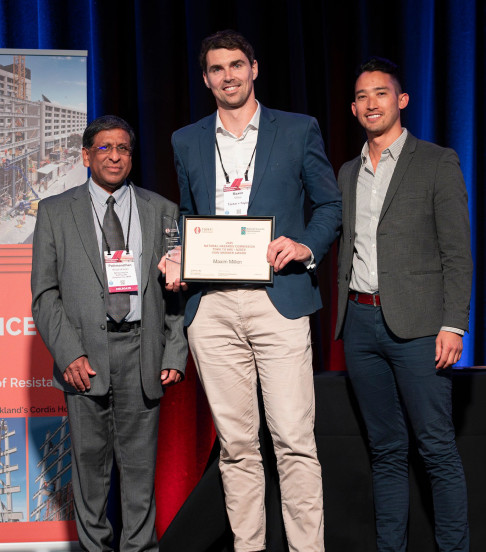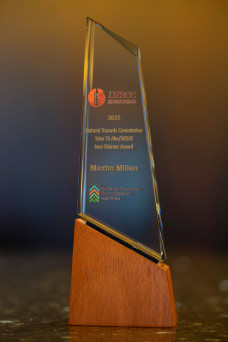Ivan Skinner Award winner bridges the gap between research and practice
Dr Maxim Millen was training to be a professional rower when the Christchurch earthquakes struck, prompting him to dedicate his career to improving New Zealand’s resilience to future earthquakes.
dedicate his career to improving New Zealand’s resilience to future earthquakes.
Millen recently received the Ivan Skinner Award at the New Zealand Society of Earthquake Engineers (NZSEE) annual conference for his outstanding contribution to earthquake resilience in New Zealand.
“It was a formative experience seeing structures that looked so strong completely crumble in the Christchurch earthquakes,” says Millen, who helped inspect buildings within the city’s redzone as part of his final year of his Bachelor of Engineering degree at University of Canterbury.
Since then, he’s continued to blur the lines between theoretical and boots-on-the-ground engineering.
As part of his PhD, Millen developed a simplified method to incorporate “rocking foundations” – when buildings are intentionally allowed to tilt or "rock" back and forth during an earthquake, instead of being completely rigid – into building design.
The new method has been incorporated into the draft TS 1170.5 – a proposed New Zealand standard which sets the methods and requirements for calculating the earthquake demands on buildings for design. Millen’s method allows for smaller foundations – which save cost and carbon emissions because they use less concrete – and also improve resilience.
“I was really stoked to have my PhD used to inform the updated design standards. It demonstrates a certain level of rigour and brings it into practical application with high impact.”
As well as designing buildings that can better withstand shaking, Millen is also interested in how what’s beneath the foundations – the soil – can contribute to a building’s resilience.
Millen is continuing his research into liquefaction through a part-time postdoctoral position under Professor Misko Cubrinovski at the University of Canterbury, studying the impact of lateral spreading – where the ground can be pulled apart during and after an earthquake His contribution to understanding these liquefaction risks and impacts around rivers and channels is helping to inform guidance into land-use around these waterways.
“Misko has been a great mentor to me throughout my career, and he’s also been the recipient of the Ivan Skinner Award, so to receive it after him is a great honour,” says Millen.
Millen’s other role is as Technical Director at Tonkin + Taylor, where he’s leading the technical development of a National Liquefaction Model.
“Having a consistent way to assess liquefaction risk across the country will help with loss modelling and land use planning,” he says.
Millen’s unique position across industry and academia helps him hone his research to real-world applications: “My research ideas are usually motivated by a gap I see in practice, so when I go off to do the research there’s an immediate use and pathway to application.”
Among Millen’s career highlights is co-founding Pensolve in 2015. Pensolve was an online software that made it easier for engineers to review their calculations, saving time and potential errors. The software was used in hundreds of buildings in NZ and overseas before closing its doors in 2021.
It’s a perfect example of Millen’s cross-discipline thinking, drive and innovation approach to creating immediately practical engineering solutions.
Natural Hazards Commission Toka Tū Ake Principal Advisor, Caleb Dunne, who presented the award to Millen says, “New Zealand continues to benefit from Maxim’s outstanding ability to bridge the gap between academic development and real-world engineering needs. We were proud to sponsor the Ivan Skinner Award and pleased to award it to Maxim this year for his incredible contributions to earthquake engineering.”
